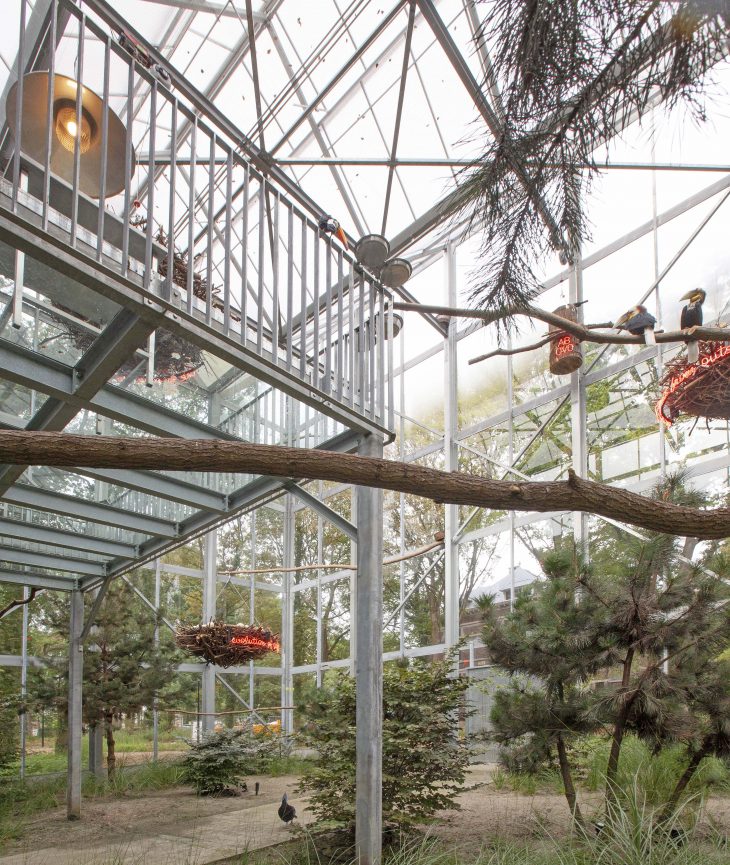Interviewing artists can be a difficult business at the best of times, but take it from me: it’s a whole lot harder when a toucan is insistently prodding the back of your jacket with its beak. The bird is one of many exotic animals – including alpacas, dromedaries, and sea eagles – in the care of the Belgian artist Koen Vanmechelen (b. 1965), whose new, purpose-built studio-cum-personal museum we are inspecting. It is an odd start to my visit to Genk, the Flemish city in which Vanmechelen is now based. Then again, there’s very little about the building that couldn’t be described as such.
Genk is not a happy place. It is a young town, urbanised from scratch when large coal deposits were discovered nearby in 1901. Developed along the lines of a garden city, its streets are separated by large tracts of greenery and roads wide enough to accommodate industrial traffic. Built entirely to serve the flourishing coal mines, it lacks anything that resembles a centre, giving it the uncanny air of a suburb amputated from its mother city.
Deindustrialisation hit hard here. From the 1960s onwards, Genk’s mines were gradually decommissioned, leaving a large number of its 60,000-strong population out of work. These economic woes were compounded when, in 2014, a Ford factory that had provided a crucial source of employment was shuttered, resulting in thousands of redundancies. With some inevitability, the local authorities have looked to culture as a possible conduit for revival, inviting Vanmechelen to relocate from nearby Hasselt.
The resulting project was always going to be intriguing. A jolly man given to quoting himself, Vanmechelen pursues a Stakhanovite agenda in pursuit of wildly esoteric goals. Put simply, his work is an unashamedly utopian proposition that straddles the boundaries between art making, activism and – less probably – animal husbandry.

Inside Koen Vanmechelen’s LABIOMISTA in Genk, Belgium Photo: Philippe van Gelooven
To give one example, Vanmechelen has spent much of the last 20 years attempting to create a global hybrid chicken: he began by mating French and Belgian varieties, pairing the result of that union with an American chicken. The pattern was repeated with breeds from across the world, widening the birds’ gene pool ever further to create a ‘cosmopolitan’ chicken. The process is both agriculturally pragmatic (Vanmechelen claims that the animals he rears are stronger and more resistant to disease than thoroughbreds) and a metaphor for the value of cross-cultural exchange. Such has been its success that he is now pursuing a similar project with pigs – some of which end up as sausages that he sells from his own hotdog van.
Subtle it isn’t, but it’s hard not to be won over by the blend of borderline messianic intent and good-natured wackiness that pervades Vanmechelen’s work. Going under the name ‘LABIOMISTA’ (Vanmechelen’s own coinage, loosely translating as ‘mixture of life’), his new studio in Genk is by some way the loudest expression to date of his outlandish vision.
The main structure is a black bunker-like building that rises several storeys above a strip mall of car dealerships and a stretch of parkland. Quite what Mario Botta, the architect behind the project, envisioned when he drew up the plans is unclear, but at first glance, its aesthetic seems to be pitched somewhere between Herzog & de Meuron’s solid industrial chic and the dystopian realm of science fiction.
The forbidding initial impression is softened by a huge greenhouse-like construction protruding from the building’s western face and offering a partial view of its interior. Within, a host of exotic birds (including that toucan) swoop through tropical plants; the scene is more than a little reminiscent of Jurassic Park. Elsewhere in the building, Vanmechelen’s taxidermy installations are displayed in the style of museum exhibits, and at its centre, a special enclosure has been created for a pair of eagles. It is all as bizarre as it sounds.

Inside Koen Vanmechelen’s LABIOMISTA in Genk, Belgium Photo: Philippe van Gelooven
From May 2019, the public will be able to access the building and the parkland around it; quite how far it will function as a public space is not yet apparent, but the hope is that it will play an important part in the city’s projected revival. Previous attempts at cultural stimulus here have been ambivalently received. In 2012, the nomadic art biennial Manifesta staged its ninth edition in Genk. According to several people I spoke to, local sentiment was largely critical; one complained of a lack of ambition on the part of the organisers, commenting that Manifesta’s presence in the city had left no real legacy.
Nevertheless, one can’t help but wish the best for LABIOMISTA. Turning Genk’s fortunes around will take more than a prominent artist pitching up with a flashy new studio, but any project as peculiar and ambitious as this one deserves all the goodwill it can summon.
From the November 2018 issue of Apollo. Preview the current issue and subscribe here.













![Masterpiece [Re]discovery 2022. Photo: Ben Fisher Photography, courtesy of Masterpiece London](http://zephr.apollo-magazine.com/wp-content/uploads/2022/07/MPL2022_4263.jpg)
‘Like landscape, his objects seem to breathe’: Gordon Baldwin (1932–2025)